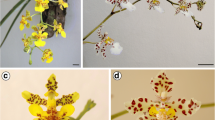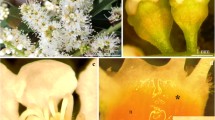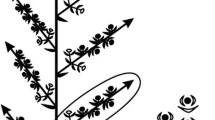Abstract
We conducted anatomical studies on glands of the Polygalaceae aiming at characterizing the morphology and function of the inflorescence glands of Caamembeca laureola (A.St.Hil & Moq.) JFB Pastore. Glucose was detected using Glicofita Plus®, and insect visitors were observed along the entire reproductive axis. Standard techniques on plant anatomy were used for observation under light and scanning electron microscopies. Gland exudation starts at anthesis, and the secretory activity continues up to the fruiting stage. The presence of glucose in the glands allows for their identification as extrafloral nectaries. The secretory tissue in the gland occupies the medullar region and is surrounded by phloem. Xylem is observed only at nectary base. The vascular bundle supplying this structure is the same one that supplies the flower bract, located at the side opposite the nectary. Our study thus lays groundwork for the investigation on the morphology of the glands found on the reproductive axis in the Polygalaceae. These glands are named as bracteal nectaries, the first such report for the entire family. This thus brings up new data and interpretations regarding the role that such structures play in the studied group and also attributes diagnostic value to the character.






Similar content being viewed by others
References
Aguiar ACA, Marques MCM, Yamamoto K (2008) Taxonomia das espécies de Polygala L. subg. Hebeclada (Chodat) S.F. Blake (Polygalaceae) ocorrentes no Brasil. Revista Brasileira de Biociências 6:91–109
Aguiar-Dias ACA, Cardoso-Gustavson P (2011) Ontogeny of the mucilage ducts of Polygala angulata DC. (Polygalaceae). J Torrey Bot Soc 138:255–261
Aguiar-Dias ACA, Yamamoto K, Castro MM (2011) Stipular extranuptial nectaries new to Polygala L.: morphology and ontogeny. Bot J Linn Soc 166:40–50
Angiosperm Phylogeny Group (2009) An update of the Angiosperm Phylogeny Group classification for the orders and families of flowering plants: APG III. Bot J Linn Soc 161:105–121
Beattie AJ, Hughes L (2002) Ant-plant interactions. In: Herrera CM, Pellmyr O (eds) Plant–animal interactions: an evolutionary approach. Blackwell Science, Oxford, pp 211–235
Bello MA, Rudall PJ, Hawkins JA (2012) Combined phylogenetic analyses reveal interfamilial relationships and patterns of floral evolution in the eudicot order Fabales. Cladistic 1:1–29
Bentley BL (1977) Extrafloral nectaries and protection by pugnacious bodyguards. Annu Rev Ecol Syst 8:407–428
Bernardello G (2007) A systematic survey of floral nectaries. In: Nicolson SW, Nepi M, Pacini E (eds) Nectaries and nectar. Springer, Dordrecht, pp 19–128
Bozzola JJ, Russell LD (1991) Electron microscopy: principles and techniques for biologists. Jones and Bartlett Publishers, New York
Castro S, Silveira P, Navarro L (2008) How flower biology and breeding system affect the reproductive success of the narrow endemic Polygala varyedae Costa (Polygalaceae). Bot J Linn Soc 157:67–81
Chodat R (1891) Monographia Polygalacearum. I. Memoires de la Société de physique et d’histoire naturelle de Genève 31:1–143
Cocucci AA, Holgado AM, Anton AM (1996) Estudio morfológico y anatómico de los eleóforos pedicelados de Dinemandra ericoides, Malpigiácea endémica del desierto de Atacama, Chile. Darwiniana 34:183–192
Cuautle M, Rico-Gray V, Diaz-Castelazo C (2005) Effects of ant behaviour and presence of extrafloral nectaries on seed dispersal of Neotropical myrmecochore Turnera ulmifolia L. (Turneraceae). Bot J Linn Soc 86:67–77
Elias TS (1972) Morphology and anatomy of foliar nectaries of Pithecellobium macradenium (Leguminosae). Bot Gaz 133:38–42
Elias TS (1980) Foliar nectaries of unusual structure in Leonardoxa africana (Leguminosae), an African obligate myrmecophyte. Am J Bot 67:423–425
Elias TS (1981) Mimosoideae. In: Polhill RM, Raven PH (eds) Advances in legume systematics, part. 1. Royal Botanic Gardens, Melbourne, pp 143–152
Elias TS (1983) Extrafloral nectaries—their structure and distribution. In: Bentley BL, Elias TS (eds) The biology of nectaries. Columbia University Press, New York, pp 74–203
Eriksen B (1993) Phylogeny of the Polygalaceae and its taxonomic implications. Plant Syst Evol 186:33–55
Eriksen B, Persson C (2007) Polygalaceae. In: Kubitzki K (ed) The families and genera of vascular plants, vol 9. Springer, Berlin, pp 345–363
Fahn A (1979) Secretory tissues in plants. Academic Press, New York
Fahn A (2000) Structure and function of secretory cells. Adv Bot Res 31:37–75
Forest F, Chase MW, Persson C, Crane PR, Hawkins JA (2007) The role of biotic and abiotic factors in evolution of ant dispersal in the milkwort family (Polygalaceae). Evolution 61:1675–1694
Francino DMT, Santana-Santos BF, Silva KLF, Thadeo M, Meira RMSA, Azevedo AA (2006) Anatomia foliar e caulinar de Chamaecrista trichopoda (Caesalpinioideae) e histoquímica do nectário extrafloral. Planta Daninha 24:695–705
Gerlach D (1969) Botanische Mikrotechnik: Eine Einführung. Georg Thieme, Stuttgart
Johansen DA (1940) Plant microtechnique. McGraw-Hill, New York
Koptur S (1992) Interactions between insects and plants mediated by extrafloral nectaries. In: Bernays E (ed) CRC series on insect/plant interactions, vol 4. CRC Press, Boca Raton, pp 85–132
Lengyel S, Gove AD, Latimer AM, Majer JD, Dunn RR (2010) Convergent evolution of seed dispersal by ants, and phylogeny and biogeography in flowering plants: a global survey. Perspect Plant Ecol Evol Syst 12:43–55
Lersten NR, Curtis JD (1987) Internal secretory spaces in Asteraceae: a review and original observations on Conyza canadensis (Tribe Astereae). Cellule 74:179–196
Lillie RD (1965) Histopathologic technic and practical histochemistry. Pt. 3. McGraw Hill, New York
Marques MCM (1979) Revisão das espécies do gênero Polygala L. (Polygalaceae) do estado do Rio de Janeiro. Rodriguésia 31:69–339
Marques MCM (1996) Securidaca L. (Polygalaceae) do Brasil. Arquivos do Jardim Botânico do Rio de Janeiro 34:7–144
Marques MCM, Peixoto AL (2007) Estudo taxonômico do gênero Polygala L. subgênero Ligustrina (Chodat) Paiva (Polygalaceae). Rodriguésia 58:95–146
Paiva J (1998) Polygalarum Africanarum et Madagascariensium prodromus atque gerontogaei generis Heterosamara Kuntze, a genere Polygala L. segregati et a nobis denus recepti, synopsis monographica. Fontqueira 50:1–347
Pastore JFB (2012) Caamembeca: generic status and new name for Polygala subgenus Ligustrina (Polygalaceae). Kew Bull 67:8–12
Pastore JFB, Abbott JR (2012) Taxonomic notes and new combinations for Asemeia (Polygalaceae). Kew Bull 67:801–813
Pastore JFB, Moraes PLR (2013) Generic status and lectotypifications for Gymnospora (Polygalaceae). Novon 22:304–306
Pastore JFB, Cardoso DBOS, Aymard GAC (2010) Synopsis, new combinations, and synonyms in Acanthocladus (Polygalaceae). Novon 20:317–324
Pizzolatti MG, Branco A, Monache FD, Cristiano R (2002) Artefatos cumarínicos isolados de Polygala paniculata L. (Polygalaceae). Revista Brasileira de Farmacognosia 12:21–26
Pizzolatti MG, Pereira WS, Monache FD (2004) A new styryl-2-pyrone derivative from Polygala sabulosa (Polygalaceae). Biochem Syst Ecol 32:603–606
Schmid R (1988) Reproductive versus extra-reproductive nectaries—historical perspective and terminological recommendations. Bot Rev 54:179–232
Solereder H (1908) Systematic anatomy of the dicotyledons. A handbook for laboratories of pure and applied botany (Translated by L.A. Boodle and F.G. Fritisch), vol 2. Claredon Press, Oxford
Author information
Authors and Affiliations
Corresponding author
Electronic supplementary material
Below is the link to the electronic supplementary material.
Rights and permissions
About this article
Cite this article
de Aguiar-Dias, A.C.A., Feio, A.C. & Pastore, J.F.B. Development, structure and function of bracteal nectaries in Caamembeca laureola (A.St.Hil & Moq.) JFB Pastore (Polygalaceae). Braz. J. Bot 38, 657–667 (2015). https://doi.org/10.1007/s40415-015-0175-5
Received:
Accepted:
Published:
Issue Date:
DOI: https://doi.org/10.1007/s40415-015-0175-5




